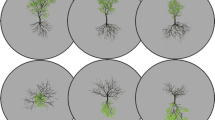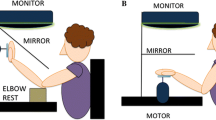Abstract
When we fixate an object in space, the rotation centers of the eyes, together with the object, define a plane of regard. People perceive the elevation of objects relative to this plane accurately, irrespective of eye or head orientation (Poljac et al. (2004) Vision Res, in press). Yet, to create a correct representation of objects in space, the orientation of the plane of regard in space is required. Subjects pointed along an eccentric vertical line on a touch screen to the location where their plane of regard intersected the touch screen positioned on their right. The distance of the vertical line to the subject’s eyes varied from 10 to 40 cm. Subjects were sitting upright and fixating one of the nine randomly presented directions ranging from 20° left and down to 20° right and up relative to their straight ahead. The eccentricity of fixations relative to the pointing location varied by up to 40°. Subjects underestimated the elevation of their plane of regard (on average by 3.69 cm, SD=1.44 cm), regardless of the fixation direction or pointing distance. However, when the targets were shown on a display mounted in a table, to provide support of the subject’s hand throughout the trial, subjects pointed accurately (average error 0.3 cm, SD=0.8 cm). In addition, head tilt 20° to the left or right did not cause any change in accuracy. The bias observed in the first task could be caused by maintained tonus in arm muscles when the arm is raised, that might interfere with the transformation from visual to motor signals needed to perform the pointing movement. We conclude that the plane of regard is correctly localized in space. This may be a good starting point for representing objects in head-centric coordinates.







Similar content being viewed by others
References
Adams W, Frisby JP, Buckley D, Gårding J, Hippisley-Cox SD, Porrill J (1996) Pooling of vertical disparities by human visual system. Perception 25:165–176
Björklund M, Crenshaw AG, Djupsjöbacka M, Johansson H (2000) Position sense acuity is diminished following repetitive low-intensity work to fatigue in a simulated occupational setting. Eur J Appl Physiol 81:361–367
Bock O (1986) Contribution of retinal versus extraretinal signals towards visual localisation in goal-directed movements. Exp Brain Res 64:476–482
Bremmer F, Schlack A, Shah NJ, Zafiris O, Kubischik M, Hoffmann K, Zilles K, Fink GR (2001) Polymodal motion processing in posterior parietal and premotor cortex: a human fMRI study strongly implies equivalencies between humans and monkeys. Neuron 29:287–296
Carrozzo M, McIntyre J, Zago M, Lacquaniti (1999) Viewer-centered and body-centered frames of reference in direct visuomotor transformations. Exp Brain Res 129:201–210
Cooke DF, Taylor CSR, Moore T, Graziano MSA (2003) Complex movements evoked by microstimulation of he ventral intraparietal area. P Natl Acad Sci USA 100:6163–6168
Desmurget M, Pelisson D, Rosetti Y, Prablanc C (1998) From eye to hand: Planning goal-directed movements. Neurosci Biobehav R 22:761–788
Duhamel JR, Bremmer F, BenHamed S, Graf W (1997) Spatial invariance of visual receptive fields in parietal cortex neurons. Nature 389:845–848
Enright JT (1995) The non-visual impact of eye orientation on eye-hand coordination. Vision Res 35:1611–1618
Gårding J, Porrill J, Mayhew JEW, Frisby JP (1995) Stereopsis, vertical disparity and relief transformations. Vision Res 35:703–722
Gardner PL, Mon-Williams M (2001) Vertical gaze angle: absolute height-in-scene information for the programming of prehension. Exp Brain Res 136:379–385
Gauthier GM, Nommay D, Vercher JL (1990) The role of ocular muscle propioception in visual localization of targets. Science 249:58–61
Graziano MS (1999) Where is my arm? The relative role of vision and proprioception in the neuronal representation of limb position. P Natl Acad Sci USA 96:10418–10421
Graziano MS, Yap GS, Gross CG (1994) Coding of visual space by premotor neurons. Science 266:1054–1057
Henriques DYP, Crawford JD (2000) Direction-dependent distortions of retinotopic space in the visuomotor transformation for pointing. Exp Brain Res 132:179–194
Henriques DYP, Klier ME, Smith MA, Lowy D, Crawford JD (1998) Gaze centered remapping of remembered visual space in an open-loop pointing task. J Neurosci 18:1583–1594
Ledin T, Fransson PA, Magnusson M (2004) Effects of postural disturbances with fatigued triceps surae muscles or with 20% additional body weight. Gait Posture 19:184–193
Lewis RF, Gaymard, BM, Tamargo RJ (1998) Efference copy provides the eye position information required for visually guided reaching. J Neurophysiol 80:1605–1608
Mayhew JEW, Longuet-Higgins HC (1982) A computational model of binocular depth perception. Nature 297:376–378
McIntyre J, Stratta F Lacquanity F (1997) A viewer-centered reference frame for pointingto memorizet targets in three-dimensional space. J Neurophysiol 78:1601–1618
Mon-Williams M, Tresilian JR (1998) A framework for considering the role of afference and efference in the control and perception of ocular position. Biol Cybern 79:175–189
Mon-Williams M, Tresilian JR (1999) Some recent studies on the extraretinal contribution to distance perception. Perception 28:167–181
Ooi TL, Wu B, He ZJ (2001) Distance determined by the angular declination below the horizon. Nature 414:197–200
Perenin MT, Jeannerod M, Prablanc C (1977) Spatial localization with paralyzed eye muscles. Ophthalmologica 175:206–214
Poljac E, van den Berg AV (2003) Representation of heading direction in far and near-head space. Exp Brain Res 151:501–513
Poljac E, Lankheet M, van den Berg AV (2004a) Perceptual compensation for eye torsion. Vision Res 45:485--496
Poljac E, Neggers SF, van den Berg AV (2004b) Collision judgment of objects approaching the head. Exp Brain Res (submitted)
Rine R, Skavenski AA (1997) Extraretinal eye position signals determine perceived target location when they conflict with visual cues. Vision Res 37:775–787
Rosetti Y, Desmurget M, Prablanc C (1995) Vectorial coding of movement: vision, proprioception or both? J Neurophysiol 74:457–463
van Beers RJ, Sitting AC, Denier van der Gon JJ (1999) Localization of a seen finger is based exclusively on proprioception and on vision of the finger. Exp Brain Res 125:43–9
van Beuzenkom AD, Medendorp WP, van Gisbergen JAM (2001) The subjective vertical and the sense of self orientation during active body tilt. Vision Res 41:3229–3242
van den Berg AV (1996) Judgments of heading. Vision Res 36:2337–2350
Acknowledgement
This study was supported by the Dutch Organization for Scientific Research, NWO, grant number ALW 810.37.006.
Author information
Authors and Affiliations
Corresponding author
Rights and permissions
About this article
Cite this article
Poljac, E., van den Berg, A.V. Localization of the plane of regard in space. Exp Brain Res 163, 457–467 (2005). https://doi.org/10.1007/s00221-004-2201-x
Received:
Accepted:
Published:
Issue Date:
DOI: https://doi.org/10.1007/s00221-004-2201-x




